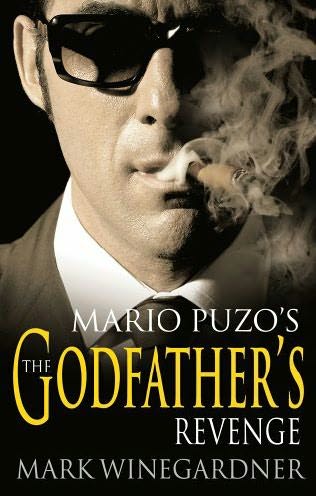The Godfather’s Revenge
Mark Winegardner
Heinemann, £16.99
ISBN 0434015601

The task, if not
art, of writing sequels to someone else’s fiction is generally a thankless one.
The best you can hope for is to be acknowledged as having carried on someone
else’s creation in a faithful way. Try to innovate, or alter, and you run the
risk of both alienating the converted and not impressing the sterner critics,
who don’t really care what happens to someone else’s franchise anyway.
But with
publishers bringing forth dreck like prequels and sequels to Pride & Prejudice
(I have my own ideas: how about AHAB’S LEG, a prequel to Moby Dick, or revisit
Dickens with LET’S TWIST AGAIN, or a modern Proust, with attitude, like YOU’LL
NEVER EAT MADELEINES IN THIS TOWN AGAIN) it is refreshing to read this book,
which does pretty much what you would hope a successor to Mario Puzo would try
to do. That is, offer a pulpy story in a serious way, written cleanly but not
flashily, with some insight along the way.
Interesting
enough, Winegardner offers his own coded take on the process in a coda to the
novel, wherein the manuscript written by one gangster and perhaps improved on by
his widow is then given to an unsuccessful novelist with artistic ambitions, who
turns it into a best-seller, much like Puzo himself. If you go back and read
the original GODFATHER, what impresses is the way Puzo’s style is so smooth, the
way he moves from broad brush strokes to finely detailed close-ups. It’s a
technique used by historical novelists with varying degrees of success: it can
provide a template for extended tree-killing doorstop books, or it can, as it
did with THE GODFATHER, help lift pulpy material.
Winegardner,
interestingly enough, has written one historical novel that I’ve read. VERA
CRUZ BLUES doesn’t fall into that blockbuster category; it’s a finely detailed
study of baseball players in the Mexican League during a brief period, just
after World War II, when that league tried to compete with the Major Leagues in
the USA. It features real characters, including Ernest Hemingway, if I remember
right, and my memory of it says that the mix of fiction and fact was done
deftly, that the characters, real or created, all were convincing, and that it
was one of the very best baseball novels I’ve read (and before you scoff,
remember that little genre includes work by Philip Roth, Robert Coover, and
Bernard Malamud, among others). Winegardner also wrote a brilliant study of a
baseball scout, PROPHET OF THE SANDLOTS, but that’s another story.
THE GODFATHER’S
REVENGE picks up the saga after the events of the second Godfather film, and
specifically deals with a thinly disguised assassination of
John Kennedy. In
many ways this is the least satisfying part of the novel, partly because we
already know so much, and so little, about the murder (something the author
admits in his fictional assassination) but also because it has been the subject
of some pretty convincing works of fiction already, so getting it ‘in disguise’
as it were is less than satisfying.
 On the other hand,
Winegardner’s strength lies in the way he brings the family issues to life: the
brilliance of the original novel and even more its first two filmed adaptation,
was the way the family was made to act as a mirror, often a distorted one, for
the activities of the crime ‘families’, and the way the latter were just as
dysfunctional, if more deadly, than the former. Here he gets to contrast life
within the Corleone family with that of Nick Gerasi, the former underboss now on
the run from the Corleones. He also knows how to build his story carefully,
before revealing what has been hidden throughout to the reader. It may seem less
than satisfying, but it reflects the progress of the plot itself. He’s also
fine on the ways the political relationships of America reflect the mob as
well. The 1964 New York World’s Fair gives ample opportunity to portray Robert
Moses as the government-appointed gangster he was, and there’s a brilliant
description of the ‘Most Special Fellows’, chappies recruited by the CIA from
the Ivy League, who were ‘made rich despite their lack of dedication or business
acumen, and positioned to run for public office…children of privilege in the
heartland, playing the role of the common man. Millions of voters bought the
act.’ Sound like any presidential son of a former CIA director (and incidently
President) you know?
On the other hand,
Winegardner’s strength lies in the way he brings the family issues to life: the
brilliance of the original novel and even more its first two filmed adaptation,
was the way the family was made to act as a mirror, often a distorted one, for
the activities of the crime ‘families’, and the way the latter were just as
dysfunctional, if more deadly, than the former. Here he gets to contrast life
within the Corleone family with that of Nick Gerasi, the former underboss now on
the run from the Corleones. He also knows how to build his story carefully,
before revealing what has been hidden throughout to the reader. It may seem less
than satisfying, but it reflects the progress of the plot itself. He’s also
fine on the ways the political relationships of America reflect the mob as
well. The 1964 New York World’s Fair gives ample opportunity to portray Robert
Moses as the government-appointed gangster he was, and there’s a brilliant
description of the ‘Most Special Fellows’, chappies recruited by the CIA from
the Ivy League, who were ‘made rich despite their lack of dedication or business
acumen, and positioned to run for public office…children of privilege in the
heartland, playing the role of the common man. Millions of voters bought the
act.’ Sound like any presidential son of a former CIA director (and incidently
President) you know?
Most importantly, Winegardner has the ability to keep the personal elements
engrossing while moving the big picture along. This melding of personal drama
with historical drama, of fact and fiction, drives the plot, rather than vice
versa. It does Puzo proud. I just wish the art department had been able to
come up with a better cover: this one has someone who looks like a Brit-pack
wannabe dressed up as a heads-up poker player swallowing cigar smoke. Doesn’t
work on virtually every level you might imagine. Next time, I’ll make them an
artistic offer they can’t refuse.

|





 On the other hand,
Winegardner’s strength lies in the way he brings the family issues to life: the
brilliance of the original novel and even more its first two filmed adaptation,
was the way the family was made to act as a mirror, often a distorted one, for
the activities of the crime ‘families’, and the way the latter were just as
dysfunctional, if more deadly, than the former. Here he gets to contrast life
within the Corleone family with that of Nick Gerasi, the former underboss now on
the run from the Corleones. He also knows how to build his story carefully,
before revealing what has been hidden throughout to the reader. It may seem less
than satisfying, but it reflects the progress of the plot itself. He’s also
fine on the ways the political relationships of America reflect the mob as
well. The 1964 New York World’s Fair gives ample opportunity to portray Robert
Moses as the government-appointed gangster he was, and there’s a brilliant
description of the ‘Most Special Fellows’, chappies recruited by the CIA from
the Ivy League, who were ‘made rich despite their lack of dedication or business
acumen, and positioned to run for public office…children of privilege in the
heartland, playing the role of the common man. Millions of voters bought the
act.’ Sound like any presidential son of a former CIA director (and incidently
President) you know?
On the other hand,
Winegardner’s strength lies in the way he brings the family issues to life: the
brilliance of the original novel and even more its first two filmed adaptation,
was the way the family was made to act as a mirror, often a distorted one, for
the activities of the crime ‘families’, and the way the latter were just as
dysfunctional, if more deadly, than the former. Here he gets to contrast life
within the Corleone family with that of Nick Gerasi, the former underboss now on
the run from the Corleones. He also knows how to build his story carefully,
before revealing what has been hidden throughout to the reader. It may seem less
than satisfying, but it reflects the progress of the plot itself. He’s also
fine on the ways the political relationships of America reflect the mob as
well. The 1964 New York World’s Fair gives ample opportunity to portray Robert
Moses as the government-appointed gangster he was, and there’s a brilliant
description of the ‘Most Special Fellows’, chappies recruited by the CIA from
the Ivy League, who were ‘made rich despite their lack of dedication or business
acumen, and positioned to run for public office…children of privilege in the
heartland, playing the role of the common man. Millions of voters bought the
act.’ Sound like any presidential son of a former CIA director (and incidently
President) you know?
